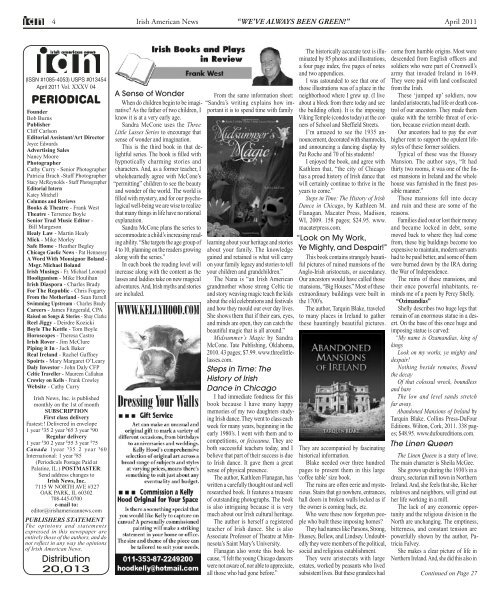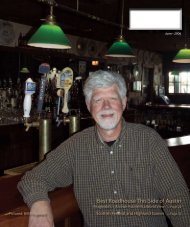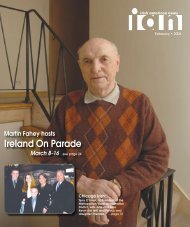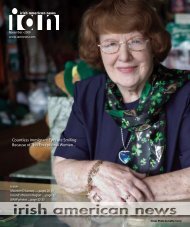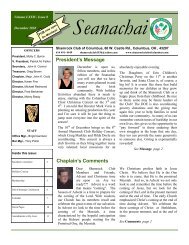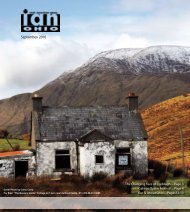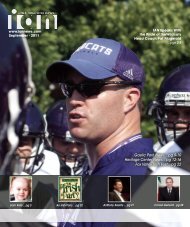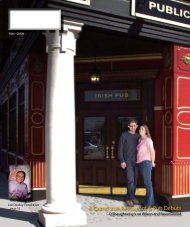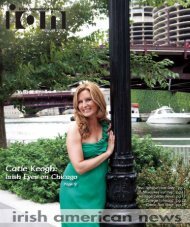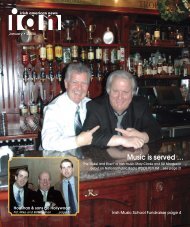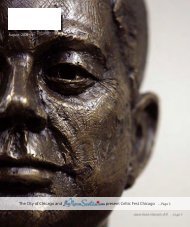Create successful ePaper yourself
Turn your PDF publications into a flip-book with our unique Google optimized e-Paper software.
4 <strong>Irish</strong> <strong>American</strong> <strong>News</strong> “We’ve Always Been Green!” <strong>April</strong> <strong>2011</strong>(ISSN #1085-4053) USPS #013454<strong>April</strong> <strong>2011</strong> Vol. XXxV 04PERIODICALFounderBob BurnsPublisherCliff CarlsonEditorial Assistant/Art DirectorJoyce EdwardsAdvertising SalesNancy MoorePhotographerCathy Curry - Senior PhotographerPatricia Brach -Staff PhotographerStacy McReynolds - Staff PhotographerEditorial InternKatey MitchellColumns and ReviewsBooks & Theatre - Frank WestTheatre - Terrence BoyleSenior Trad Music Editor -Bill MargesonHealy Law - Martin HealyMick - Mike MorleySafe Home - Heather BegleyChicago Gaelic <strong>News</strong> - Pat HennessyA Word With Monsignor Boland -Msgr. Michael Boland<strong>Irish</strong> Musings - Fr. Michael LeonardHooliganism - Mike Houlihan<strong>Irish</strong> Diaspora - Charles BradyFor The Republic - Chris FogartyFrom the Motherland - Sean FarrellSwimming Upstream - Charles BradyCareers - James Fitzgerald, CPARaised on Songs & Stories - Shay ClarkeReel Jiggy - Deirdre KozickiBoyle The Kettle - Tom BoyleHoroscopes - Theresa Castro<strong>Irish</strong> Rover - Jim McClurePiping it In - Jack BakerReal Ireland - Rachel GaffneySpoirts - Mary Margaret O’LearyDaly Investor - John Daly CFPCeltic Traveller - Maureen CallahanCrowley on Kells - Frank CrowleyWebsite - Cathy Curry<strong>Irish</strong> <strong>News</strong>, Inc. is publishedmonthly on the 1st of monthSubscriptionFirst class deliveryFastest:! Delivered in envelope1 year $ 35 2 year $ 65 3 year $ 90Regular delivery1 year $ 30 2 year $ 55 3 year $ 75Canada 1year $ 35 2 year $ 60International: 1 year $ 85(Periodicals Postage Paid atPalatine, IL.) Postmaster:Send address changes to<strong>Irish</strong> <strong>News</strong>, Inc.7115 W North Ave #327Oak Park, il 60302708-445-0700e-mail to:editor@irishamericannews.comPUBLISHERS STATEMENTThe opinions and statementsexpressed in this newspaper areentirely those of the authors, and donot reflect in any way the opinionsof <strong>Irish</strong> <strong>American</strong> <strong>News</strong>.Distribution20,013A Sense of WonderWhen do children begin to be imaginative?As the father of two children, Iknow it is at a very early age.Sandra McCone uses the ThreeLittle Lasses Series to encourage thatsense of wonder and imagination.This is the third book in that delightfulseries. The book is filled withhypnotically charming stories andcharacters. And, as a former teacher, Iwholeheartedly agree with McCone’s“permitting” children to see the beautyand wonder of the world. The world isfilled with mystery, and for our psychologicalwell-being we are wise to realizethat many things in life have no rationalexplanation.Sandra McCone plans the series toaccommodate a child’s increasing readingability. “She targets the age group of4 to 10, planning on the readers growingalong with the series.”In each book the reading level willincrease along with the content as thelasses and laddies take on new magicaladventures. And, <strong>Irish</strong> myths and storiesare included.From the same information sheet:“Sandra’s writing explains how importantit is to spend time with familylearning about your heritage and storiesabout your family. The knowledgegained and retained is what will carryon your family legacy and stories to tellyour children and grandchildren.”The Nana is “an <strong>Irish</strong> <strong>American</strong>grandmother whose strong Celtic tieand story weaving magic teach the kidsabout the old celebrations and festivalsand how they mould our ever day lives.She shows them that if their ears, eyes,and minds are open, they can catch thebeautiful magic that is all around.”Midsummer’s Magic by SandraMcCone. Tate Publishing, Oklahoma,2010. 43 pages; $7.99. www.threelittlelasses.com.Steps in Time: TheHistory of <strong>Irish</strong>Dance in ChicagoI had immediate fondness for thisbook because I have many happymemories of my two daughters studying<strong>Irish</strong> dance. They went to class eachweek for many years, beginning in theearly 1980’s. I went with them and tocompetitions, or feiseanna. They areboth successful teachers today, and Ibelieve that part of their success is dueto <strong>Irish</strong> dance. It gave them a greatsense of physical presence.The author, Kathleen Flanagan, haswritten a carefully thought out and wellresearched book. It features a treasureof outstanding photographs. The bookis also intriguing because it is verymuch about our <strong>Irish</strong> cultural heritage.The author is herself a registeredteacher of <strong>Irish</strong> dance. She is alsoAssociate Professor of Theatre at Minnesota’sSaint Mary’s University.Flanagan also wrote this book because,“I felt the young Chicago dancerswere not aware of, nor able to appreciate,all those who had gone before.”The historically accurate text is illuminatedby 85 photos and illustrations,a four page index, five pages of notesand two appendices.I was astounded to see that one ofthose illustrations was of a place in theneighborhood where I grew up. (I liveabout a block from there today and seethe building often). It is the imposingViking Temple (condos today) at the cornersof School and Sheffield Streets.I’m amazed to see the 1935 announcement,decorated with shamrocks,and announcing a dancing display byPat Roche and 70 of his students!I enjoyed the book, and agree withKathleen that, “the city of Chicagohas a proud history of <strong>Irish</strong> dance thatwill certainly continue to thrive in theyears to come.”Steps in Time: The History of <strong>Irish</strong>Dance in Chicago, by Kathleen M.Flanagan. Macater Press, Madison,WI, 2009. 158 pages; $24.95. www.macaterpress.com.“Look on My Work,Ye Mighty, and Despair!”This book contains strangely beautifulpictures of ruined mansions of theAnglo-<strong>Irish</strong> aristocrats, or ascendancy.Our ancestors would have called thosemansions, “Big Houses.” Most of theseextraordinary buildings were built inthe 1700’s.The author, Tarquin Blake, traveledto many places in Ireland to gatherthese hauntingly beautiful pictures.They are accompanied by fascinatinghistorical information.Blake needed over three hundredpages to present them in this large‘coffee table’ size book.The ruins are often eerie and mysterious.Stairs that go nowhere, entrances,hall doors in broken walls locked as ifthe owner is coming back, etc.Who were these now forgotten peoplewho built these imposing homes?They had names like Parsons, Strong,Hussey, Bellew, and Lindsey. Undoubtedlythey were members of the political,social and religious establishment.They were aristocrats with largeestates, worked by peasants who livedsubsistent lives. But these grandees hadcome from humble origins. Most weredescended from English officers andsoldiers who were part of Cromwell’sarmy that invaded Ireland in 1649.They were paid with land confiscatedfrom the <strong>Irish</strong>.These ‘jumped up’ soldiers, nowlanded aristocrats, had life or death controlof our ancestors. They made themquake with the terrible threat of eviction,because eviction meant death.Our ancestors had to pay the everhigher rent to support the opulent lifestylesof these former soldiers.Typical of these was the HusseyMansion. The author says, “It hadthirty two rooms, it was one of the finestmansions in Ireland and the wholehouse was furnished in the finest possiblemanner.”These mansions fell into decayand ruin and these are some of thereasons.Families died out or lost their moneyand became locked in debt, somemoved back to where they had comefrom, these big buildings become tooexpensive to maintain, modern servantshad to be paid better, and some of themwere burned down by the IRA duringthe War of Independence.The ruins of these mansions, andtheir once powerful inhabitants, remindsme of a poem by Percy Shelly.“Ozimandias”Shelly describes two huge legs thatremain of an enormous statue in a desert.On the base of this once huge andimposing statue is carved:“My name is Ozamandias, king ofkingsLook on my works, ye mighty anddespair!Nothing beside remains, Roundthe decayOf that colossal wreck, boundlessand bareThe low and level sands stretchfar away.Abandoned Mansions of Ireland byTarquin Blake. Collins Press-DuFourEditions. Wilton, Cork, <strong>2011</strong>. 338 pages;$48.95. www.dufoureditions.com.The Linen QueenThe Linen Queen is a story of love.The main character is Sheila McGee.She grows up during the 1930’s in adreary, sectarian mill town in NorthernIreland. And, she feels that she, like herrelatives and neighbors, will grind outher life working in a mill.The lack of any economic opportunityand the religious division in theNorth are unchanging. The emptiness,bitterness, and constant tension arepowerfully shown by the author, PatriciaFalvey.She makes a clear picture of life inNorthern Ireland. And, she did this also inContinued on Page 27


